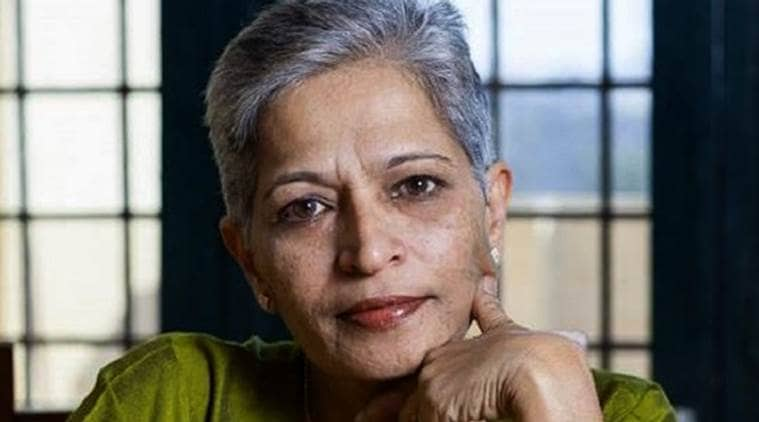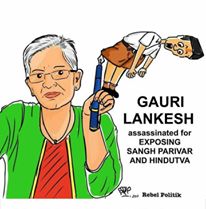Gauri Lankesh murder case: K T Naveen Kumar, 37, who was arrested on February 18 by the Bengaluru police for illegal possession of bullets, has been named as the first accused in the case.
 Gauri Lankesh murder case: When Kumar was produced before the court of an additional chief metropolitan magistrate, the SIT gave the court a sealed copy of a confession statement given by him about his involvement in the murder. (File)A Special Investigation Team (SIT) probing the September 5, 2017 killing of journalist-activist Gauri Lankesh, 55, carried out its first arrest in the case on Friday. K T Naveen Kumar, 37, who was arrested on February 18 by the Bengaluru Police for illegal possession of bullets, has been named as the first accused in the case.
Gauri Lankesh murder case: When Kumar was produced before the court of an additional chief metropolitan magistrate, the SIT gave the court a sealed copy of a confession statement given by him about his involvement in the murder. (File)A Special Investigation Team (SIT) probing the September 5, 2017 killing of journalist-activist Gauri Lankesh, 55, carried out its first arrest in the case on Friday. K T Naveen Kumar, 37, who was arrested on February 18 by the Bengaluru Police for illegal possession of bullets, has been named as the first accused in the case.
The SIT arrested Kumar, a resident of Maddur in Mandya, after informing a magistrate’s court in Bengaluru that it had found evidence of his involvement in the Gauri Lankesh murder in the course of the investigation into the illegal arms case for which he was arrested on February 18.
The SIT initially sought a warrant for Kumar’s arrest in the Gauri Lankesh case — shortly after he was remanded in judicial custody in the illegal arms case — citing voluntary statements given by some of Kumar’s friends about his links to the Gauri Lankesh murder.
When Kumar was produced before the court of an additional chief metropolitan magistrate, the SIT gave the court a sealed copy of a confession statement given by him about his involvement in the murder. An assistant public prosecutor, Nirmala Rani, presented a remand plea to the court seeking police custody of Kumar for eight days in order to unearth the larger conspiracy and materials used in the crime.
“At present, only one accused has been named. Others will be added after investigations. This suspect was traced on the basis of CCTV footage,” said Rani. Kumar was arrested under the jurisdiction of the Upparpet police station in west Bengaluru on February 18 based on a complaint filed by a crime branch official stating that he was caught with bullets in the city bus stand.
The investigations in the Upparpet case show that Kumar, during conversations about guns and ammunition with some of his friends from Maddur, had alluded to his links to the murder of Gauri Lankesh. SIT officials have already questioned Kumar on a few occasions since his arrest on February 18.
Investigations have shown that Kumar is linked to a radical Hindutva outfit called the Hindu Yuva Sena and that he is also allegedly linked to members of the Sanatan Sanstha outfit and its affiliate the Hindu Janajagruti Samiti. He has been found in possession of more than 15 rounds of the cartridges of the .32 calibre, which are the same as the 7.65 mm cartridges.
Gauri Lankesh was shot with a 7.65 mm country-made pistol in the driveway of her home in west Bengaluru on the evening of September 5, 2017 by an unidentified man wearing a helmet. The suspect who rode the getaway motorcycle was also unidentified.
Investigations by the SIT has unearthed CCTV footage of a man conducting a recce of the journalist’s home a few hours ahead of her killing. The physical structure of the man found conducting the recce in the CCTV footage has a close resemblance to that of Kumar.
A forensic analysis of four empty cartridges and the four bullets fired to kill Gauri Lankesh has shown that markings on the bullets and cartridges match with markings found on the bullets and cartridges fired to kill the Kannada scholar and researcher M M Kalburgi, 77, in the northern Karnataka town of Dharwad on August 30, 2015. The forensic analysis suggests that Gauri Lankesh and scholar Kalburgi were shot with the same 7.65 mm pistol.
The findings from the comparison of the ballistic evidence from the Gauri Lankesh and Kalburgi cases adds to existing forensic evidence from the shooting of the leftist thinker Govind Pansare, 81, in Kohlapur in Maharashtra on February 16, 2015 where the exact same 7.65 mm country-made gun used in the Kalburgi murder was found to have been used.
More significantly, six months prior to the Kalburgi killing, rationalist Govind Pansare was killed in Mumbai in Maharashtra with bullets being pumped from two guns – some of these bullets match the ones used in the Lankesh and Kalburgi murders. And interestingly, the bullets from the second gun that shot at Pansare match the bullets used to kill another rationalist and anti-superstition activist Narendra Dabholkar in Maharashtra’s Pune in 2013.
The inter-twining of the ballistic evidence could help in cracking down on all the cases – especially since the modus operandi of two bike-borne gunmen accosting the victims and shooting them at point-blank range is also another pattern that runs through.
The other commonality is that they were all shot for their rationalist thoughts and activism
Since these murders are all being probed by four different agencies – the SIT for Lankesh, the Karnataka CID for Kalburgi, the Maharashtra police probing Pansare’s murder and the Central Bureau of Investigation is probing the Dabholkar killing – the coordination between the different investigations could well take longer.
But in all this, the ballistic evidence could be the most crucial.
http://indianexpress.com/article/india/breakthrough-journalist-gauri-lankesh-murder-first-arrest-5084078/

March 3, 2018 at 4:16 pm
The accused in the murder of activist Gauri Lankesh being arrested is a positive development. Other accomplices should also be probed by the authority in charge